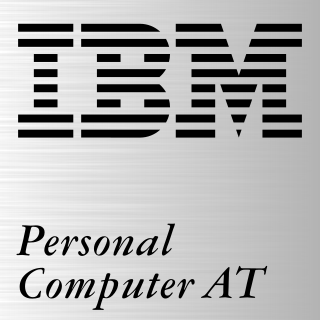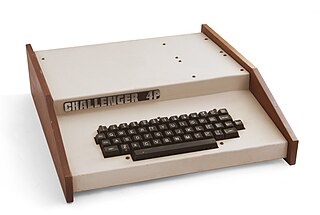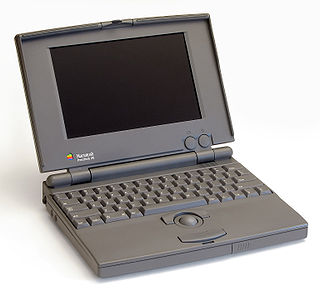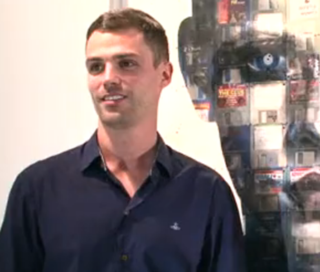Related Research Articles

A floppy disk or floppy diskette is an obsolescent type of disk storage composed of a thin and flexible disk of a magnetic storage medium in a square or nearly square plastic enclosure lined with a fabric that removes dust particles from the spinning disk. Floppy disks store digital data which can be read and written when the disk is inserted into a floppy disk drive (FDD) connected to or inside a computer or other device.

The MOS Technology 6502 is an 8-bit microprocessor that was designed by a small team led by Chuck Peddle for MOS Technology. The design team had formerly worked at Motorola on the Motorola 6800 project; the 6502 is essentially a simplified, less expensive and faster version of that design.

The TRS-80 Micro Computer System is a desktop microcomputer launched in 1977 and sold by Tandy Corporation through their Radio Shack stores. The name is an abbreviation of Tandy Radio Shack, Z80 [microprocessor]. It is one of the earliest mass-produced and mass-marketed retail home computers.
Kaypro Corporation was an American home and personal computer manufacturer based out of San Diego in the 1980s. The company was founded by Non-Linear Systems (NLS) to compete with the popular Osborne 1 portable microcomputer. Kaypro produced a line of rugged, "luggable" CP/M-based computers sold with an extensive software bundle which supplanted its competitors and quickly became one of the top-selling personal computer lines of the early 1980s.

The IBM Personal Computer/AT was released in 1984 as the fourth model in the IBM Personal Computer line, following the IBM PC/XT and its IBM Portable PC variant. It was designed around the Intel 80286 microprocessor.

VEB Kombinat Robotron was the biggest East German electronics manufacturer. It was based in Dresden and employed 68,000 people (1989). It produced personal computers, SM EVM minicomputers, the ESER mainframe computers, several computer peripherals as well as home computers, radios, television sets and other items including the cookie press Kleingebäckpresse Typ 102.

A USB flash drive is a data storage device that includes flash memory with an integrated USB interface. It is typically removable, rewritable and much smaller than an optical disc. Most weigh less than 30 g (1 oz). Since first appearing on the market in late 2000, as with virtually all other computer memory devices, storage capacities have risen while prices have dropped. As of March 2016, flash drives with anywhere from 8 to 256 gigabytes (GB) were frequently sold, while 512 GB and 1 terabyte (TB) units were less frequent. As of 2018, 2 TB flash drives were the largest available in terms of storage capacity. Some allow up to 100,000 write/erase cycles, depending on the exact type of memory chip used, and are thought to physically last between 10 and 100 years under normal circumstances.

Yoshiro Nakamatsu, also known as Dr. NakaMats, is a Japanese inventor. He regularly appears on Japanese talk shows demonstrating his inventions.

George Wesley Bellows was an American realist painter, known for his bold depictions of urban life in New York City. He became, according to the Columbus Museum of Art, "the most acclaimed American artist of his generation".

This article is about the various external peripherals of the Commodore 64 home computer. Due to the backwards compatibility of the Commodore 128, most peripherals will work on that system, as well. There's some compatibility with the VIC-20 and PET too.

Ohio Scientific Inc. was an Ohio-based computer company that built and marketed microcomputers from 1975 to 1981. Their best-known products were the Challenger series of microcomputers and Superboard single-board computer kits.

The PowerBook 100 is a portable subnotebook personal computer designed and manufactured by Sony for Apple Computer and introduced on October 21, 1991, at the COMDEX computer expo in Las Vegas, Nevada. Priced at US$2,500 with external floppy drive, the PowerBook 100 was the low-end model of the first three simultaneously released PowerBooks. Its CPU and overall speed closely resembled those of its predecessor, the Macintosh Portable. It had a Motorola 68000 processor at 16 MHz, 2-8 megabytes (MB) of RAM, a 9-inch (23 cm) monochrome backlit liquid crystal display (LCD) with 640 × 400 pixel resolution, and the System 7.0.1 operating system. It did not have a built-in floppy disk drive and was noted for its unique compact design that placed a trackball pointing device in front of the keyboard for ease of use.

The history of the personal computer as a mass-market consumer electronic device began with the microcomputer revolution of the 1970s. A personal computer is one intended for interactive individual use, as opposed to a mainframe computer where the end user's requests are filtered through operating staff, or a time-sharing system in which one large processor is shared by many individuals. After the development of the microprocessor, individual personal computers were low enough in cost that they eventually became affordable consumer goods. Early personal computers – generally called microcomputers – were sold often in electronic kit form and in limited numbers, and were of interest mostly to hobbyists and technicians.

ecycler is an environmental technology company and brand that provides a marketplace for discarders and collectors of recyclable waste in areas where no organized pickup is available.

The Pyréolophore was probably the world's first internal combustion engine. It was invented in the early 19th century in Chalon-sur-Saône, France, by the Niépce brothers: Nicéphore and Claude. In 1807 the brothers ran a prototype internal combustion engine, and on 20 July 1807 a patent was granted by Napoleon Bonaparte after it had successfully powered a boat upstream on the river Saône.

Nicholas James Gentry is a British artist from London. Much of his artistic output has been generated with the use of contributed artefacts and materials. He states that through this process "contributor, artist and viewer come closer together". His art is influenced by the development of consumerism, technology, identity and cyberculture in society, with a distinctive focus on obsolete media.
The College of Engineering Vadakara (CEV) is an engineering college in Kozhikode district of Kerala, established in 1999.
Microsoft .NET Gadgeteer is an open-source rapid-prototyping standard for building small electronic devices using the Microsoft .NET Micro Framework and Microsoft Visual Studio/Visual C# Express.

The metal–oxide–semiconductor field-effect transistor, also known as the metal–oxide–silicon transistor, is a type of insulated-gate field-effect transistor (IGFET) that is fabricated by the controlled oxidation of a semiconductor, typically silicon. The voltage of the covered gate determines the electrical conductivity of the device; this ability to change conductivity with the amount of applied voltage can be used for amplifying or switching electronic signals.
References
- ↑ Chambers, James (2010). "Floppy Legs Portable Hard Drive and Gesundheit Radio from the Attenborough Design Group project". Museum of Modern Art (New York). Retrieved 1 August 2012.
- 1 2 James Chambers' website: Artificial Defence Mechanisms. Retrieved 1 August 2012.
- ↑ Pitzke, Marc (New York) (25 July 2011). "Kunst: Design-Ausstellung in MoMA". Maschinen grinsen uns an. Spiegel Online Kultur. Retrieved 1 August 2012.
- ↑ Hannaford, Kat (8 February 2010). "Gesundheit Radio Sneezes to Remove Dust". Gizmodo.com. Retrieved 23 July 2012.
- ↑ Wiktionary: Gesundheit
- ↑ Chambers, James (August 2010). "Design Interactions at the RCA". Attenborough Design Group. Royal College of Art. Archived from the original on 2012-12-23. Retrieved 1 August 2012.
- 1 2 Lachut, Scott (20 July 2010). "Project Explores Truly Personal Electronics Design". PSFK. Retrieved 1 August 2012.
- 1 2 Sorrel, Charlie (20 July 2010). "Gadget Lab". Hydrophophic Floppy-Drive Leaps Away From Spills. WIRED. Retrieved 1 August 2012.
- ↑ "Developed to Protect Early Microprocessors". we-make-money-not-art.com. 7 February 2010. Retrieved July 23, 2012.
- ↑ Gesundheit Radio on Vimeo, showing the artwork's "sneeze" mechanism. Retrieved 1 August 2012.
- ↑ Davies, Chris (8 February 2010). "Gesundheit Radio sneezes away the dust". SlashGear. Retrieved 1 August 2012.
- ↑ Heimbuch, Jaymi (10 February 2010). "Could Making Our Electronics Sneeze Extend Their Life? The Gesundheit Radio Says Yes". Treehugger. Retrieved 1 August 2012.